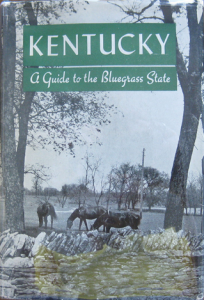From Tour #3 (Cincinnati, Ohio) Newport Cynthiana Paris Lexington Nicholasville Lancaster Somerset (Chattanooga, Tenn.) .
[US 27] Page 251
CYNTHIANA, 64.7 m. (718 alt., 4,386 pop.), lying in the outer Bluegrass region, on the banks of the South Fork of Licking River, is a residential town with a leisurely social life, and a background of tradition, culture, and wealth. Established in 1793 and incorporated in 1806, Cynthiana was named for Cynthia and Anna, two daughters of the first settler, Robert Harrison. The stately old red-brick HARRISON COUNTY COURTHOUSE, Main St., was built in 1851 in Greek Revival style, with an octagonal clock tower. Preserved in this building are valuable county records, many of them bearing the handwriting of prominent statesmen, including Henry Clay who in 1801 was admitted to the bar of the Quarter Sessions Court at Cynthiana.
Directly back of the courthouse square is an old log house, built in 1790 and used successively as a courthouse, law office, printing office, photograph gallery, and residence. In this house Bishop H. H. Kavanaugh and Ambrose Dudley Mann, later special commissioner of the United States Government to the German States (1846), special agent to Hungary (1849), and to Switzerland (1850), served as apprentices. The Guardian of Liberty, Cynthiana’s first newspaper, was also published in this old building. A left wing, also built of logs, has been added recently.
The JUDGE BOYD PLACE, on Pike St. R. from Main St., faces the river. This mansion, built in 1807 and designed in the late Georgian Colonial manner, is still in excellent condition. On the outskirts of town, on N. Main St., is a BURYING GROUND established in 1793; it contains many old gravestones.
Cynthiana was the scene of a severe battle during the War between the States. On July 17, 1862, Gen. John H. Morgan, with about 800 men, captured the town which was defended by a Federal force under Col. John J. Landrum. Much of the fighting was around the old covered bridge over the Licking River.
Again in 1864 General Morgan, with 1,200 men, captured the town after two days’ fighting. Federal forces, under the command of Gen. E. H. Hobson, surrendered. On Sunday morning, June 12, 1864, the day after the battle, General Morgan’s troops, fatigued from the fighting, were suddenly attacked by Gen. Stephen G. Burbridge and a force of 5,000 fresh troops. This surprise attack resulted in the retreat of General Morgan’s troops. Most of the business section of Cynthiana was destroyed by fire during the fighting and the loss of life on both sides was unusually heavy.
Cynthiana is at the junction with US 62 (see Tour 14).
Left from Cynthiana on Millersburg Rd. to BATTLE GROVE CEMETERY, 1 m., the site of the second day’s battle on June 12, 1864. A Confederate monument, erected in 1869, memorializes the spot. A monument here to the memory of Harrison County soldiers who lost their lives in the Mexican War was erected in 1848 on the Courthouse Square, but was moved to Battle Grove in 1868.
Between Cynthiana and Stanford the route, bordered with old stone walls and shaded by rows of honeylocust trees, goes through the inner Bluegrass, one of the most fertile agricultural regions in the country. It was a landowner in this region who, upon hearing one night from a guest that there was a weed in one of his 10-acre pastures, got up and went hunting with lights and lanterns until he found it. Judging from the neatness of the pastures, the story might well be true; barns and stables in the Bluegrass are clean as can be, the old elms and beech trees in the pastures show signs of careful pruning, and the stone walls are neatly and strongly built, some having stood for more than 150 years with no help from cement. In many places the mansion with its attendant barns, trainers’ and laborers’ quarters, stables, and paddocks has the look of a small prim village.
In the early days, settlers on this fertile land used it to produce almost all of their needs corn, wheat, hogs, sheep, cows, horses, bluegrass for pasture, clover for hay, and oats for feed. Hemp and tobacco were grown to be sold, and from the beginning the horse was an important product. But as the western corn and wheat lands were opened to settlement, the functions of the Bluegrass farms decreased in number.
Cultivation of tobacco and the breeding of horses are predominant now, the Bluegrass farmer often finding it cheaper to buy his oats and corn than to use precious tobacco land and pasturage for their cultivation.
PEAVINE’S HIGHLAND CHIEF STUD, the well-known saddle horse farm (L), at 68.1 m., is typical of many in the Bluegrass region. Harrison Chief, the prize winner admired by all lovers of the Kentucky saddle horse, was bred here; his stall is still preserved.
Across the Licking River from the tiny settlement of LAIR, 69.2 m., is the LEWIS HUNTER DISTILLERY (open), still producing the same brand of whisky it made in the 1860’s.
The EWALT HOUSE (open), 75.2 m., was built (R) in 1794 by Henry Ewalt, a soldier in the Revolutionary War. On a 200-acre tract, for which he paid 110 pounds sterling, he erected a two-story frame house with a stone chimney, seven feet wide and three feet deep at the base, at each end. About 1808 a stone ell of four rooms was added to the house; its walls are 22 inches thick. The interior walls are paneled in ash and walnut and decorated with hand-carved moldings. This site has belonged to the Ewalt family since 1788. In the old burying ground near the house are graves of several members of the Ewalt family.
Credit —
Title: Kentucky; a guide to the Bluegrass state
Author: Federal Writers’ Project of the Work Projects Administration for the State of Kentucky
COPYRIGHT, 1939, BY THE UNIVERSITY OF KENTUCKY

